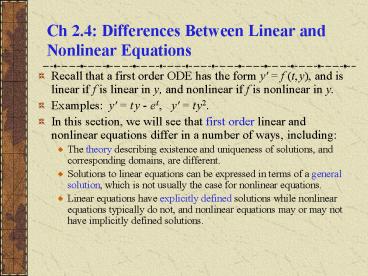Ch 2.4: Differences Between Linear and Nonlinear Equations PowerPoint PPT Presentation
1 / 6
Title: Ch 2.4: Differences Between Linear and Nonlinear Equations
1
Ch 2.4 Differences Between Linear and Nonlinear
Equations
- Recall that a first order ODE has the form y' f
(t, y), and is linear if f is linear in y, and
nonlinear if f is nonlinear in y. - Examples y' t y - e t, y' t y2.
- In this section, we will see that first order
linear and nonlinear equations differ in a number
of ways, including - The theory describing existence and uniqueness of
solutions, and corresponding domains, are
different. - Solutions to linear equations can be expressed in
terms of a general solution, which is not usually
the case for nonlinear equations. - Linear equations have explicitly defined
solutions while nonlinear equations typically do
not, and nonlinear equations may or may not have
implicitly defined solutions.
2
Theorem 2.4.1
- Consider the linear first order initial value
problem - If the functions p and g are continuous on an
open interval (?, ? ) containing the point t
t0, then there exists a unique solution y ?(t)
that satisfies the IVP for each t in (?, ? ). - Proof outline Use Ch 2.1 discussion and results
3
Theorem 2.4.2
- Consider the nonlinear first order initial value
problem - Suppose f and ?f/?y are continuous on some open
rectangle (t, y) ? (?, ? ) x (?, ? ) containing
the point (t0, y0). Then in some interval (t0 -
h, t0 h) ? (?, ? ) there exists a unique
solution y ?(t) that satisfies the IVP. - Proof discussion Since there is no general
formula for the solution of arbitrary nonlinear
first order IVPs, this proof is difficult, and is
beyond the scope of this course. - It turns out that conditions stated in Thm 2.4.2
are sufficient but not necessary to guarantee
existence of a solution, and continuity of f
ensures existence but not uniqueness of ?.
4
Example 1 Linear IVP
- Recall the initial value problem from Chapter 2.1
slides - The solution to this initial value problem is
defined for - t gt 0, the interval on which p(t) -2/t is
continuous. - If the initial condition is y(-1) 2, then the
solution is given by same expression as above,
but is defined on t lt 0. - In either case, Theorem 2.4.1
- guarantees that solution is unique
- on corresponding interval.
5
Example 2 Nonlinear IVP (1 of 2)
- Consider nonlinear initial value problem from Ch
2.2 - The functions f and ?f/?y are given by
- and are continuous except on line y 1.
- Thus we can draw an open rectangle about (0, -1)
on which f and ?f/?y are continuous, as long as
it doesnt cover y 1. - How wide is rectangle? Recall solution defined
for x gt -2, with
6
Example 2 Change Initial Condition (2 of 2)
- Our nonlinear initial value problem is
- with
- which are continuous except on line y 1.
- If we change initial condition to y(0) 1, then
Theorem 2.4.2 is not satisfied. Solving this new
IVP, we obtain - Thus a solution exists but is not unique.

